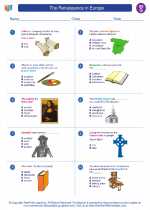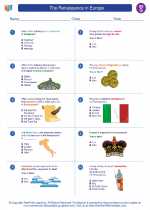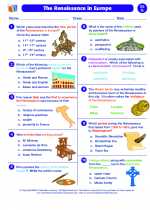The Renaissance in Europe
What do you know about the Renaissance in Europe? The European Renaissance was a time of social, scientific, artistic, and religious rebirth. From 1463 to 1650, inventors, artists, philosophers, and scientists created and brought to light new ideas and perspectives that changed the shape of society and daily life. Read More...
◂Social Studies Worksheets and Study Guides Seventh Grade. The Renaissance in Europe
Study Guide The Renaissance in Europe
The Renaissance in Europe  Worksheet/Answer key
Worksheet/Answer key The Renaissance in Europe
The Renaissance in Europe  Worksheet/Answer key
Worksheet/Answer key The Renaissance in Europe
The Renaissance in Europe  Worksheet/Answer key
Worksheet/Answer key The Renaissance in Europe
The Renaissance in Europe  Worksheet/Answer key
Worksheet/Answer key The Renaissance in Europe
The Renaissance in Europe 

 Worksheet/Answer key
Worksheet/Answer key
 Worksheet/Answer key
Worksheet/Answer key
 Worksheet/Answer key
Worksheet/Answer key
 Worksheet/Answer key
Worksheet/Answer key

The resources above cover the following skills:
National Curriculum Standards for Social Studies (NCSS)
TIME, CONTINUITY, AND CHANGE
SOCIAL STUDIES PROGRAMS SHOULD INCLUDE EXPERIENCES THAT PROVIDE FOR THE STUDY OF THE PAST AND ITS LEGACY.
KNOWLEDGE - Learners will understand:
The study of the past provides a representation of the history of communities, nations, and the world.
That learning about the past requires the interpretation of sources, and that using varied sources provides the potential for a more balanced interpretive record of the past.
That historical interpretations of the same event may differ on the basis of such factors as conflicting evidence from varied sources, national or cultural perspectives, and the point of view of the researcher.
Key historical periods and patterns of change within and across cultures (e.g., the rise and fall of ancient civilizations, the development of technology, the rise of modern nation-states, and the establishment and breakdown of colonial systems).
The contributions of key persons, groups, and events from the past and their influence on the present.
The influences of social, geographic, economic, and cultural factors an the history of local areas, states, nations, and the world.
National Center for History in Schools (NCHS)
Historical Thinking Standards
Chronological Thinking
Identify the temporal structure of a historical narrative or story.
Reconstruct patterns of historical succession and duration; explain historical continuity and change.
Historical Comprehension
Reconstruct the literal meaning of a historical passage.
Identify the central question(s) the historical narrative addresses.
Historical Analysis and Interpretation
Draw comparisons across eras and regions in order to define enduring issues.
Challenge arguments of historical inevitability.
Hold interpretations of history as tentative.
Historical Research Capabilities
Formulate historical questions.
Historical Issues-Analysis and Decision-Making
Identify issues and problems in the past.
Identify relevant historical antecedents.
World History Content Standards
Era 3: Classical Traditions, Major Religions, and Giant Empires, 1000 BCE-300 CE
The emergence of Aegean civilization and how interrelations developed among peoples of the eastern Mediterranean and Southwest Asia, 600-200 BCE.
The student understands the major cultural achievements of Greek civilization.
Era 5: Intensified Hemispheric Interactions 1000-1500 CE
The redefining of European society and culture, 1000-1300 CE.
The student understands the patterns of social change and cultural achievement in Europe’s emerging civilizations.
Patterns of crisis and recovery in Afro-Eurasia, 1300-1450
The student understands transformations in Europe following the economic and demographic crises of the 14th century.
Major global trends from 1000-1500 CE.
The student understands major global trends from 1000 to 1500 CE.
Era 6: The Emergence of the First Global Age, 1450-1770
How European society experienced political, economic, and cultural transformations in an age of global intercommunication, 1450-1750.
The student understands demographic, economic, and social trends in Europe.
The student understands the Renaissance, Reformation, and Catholic Reformation.